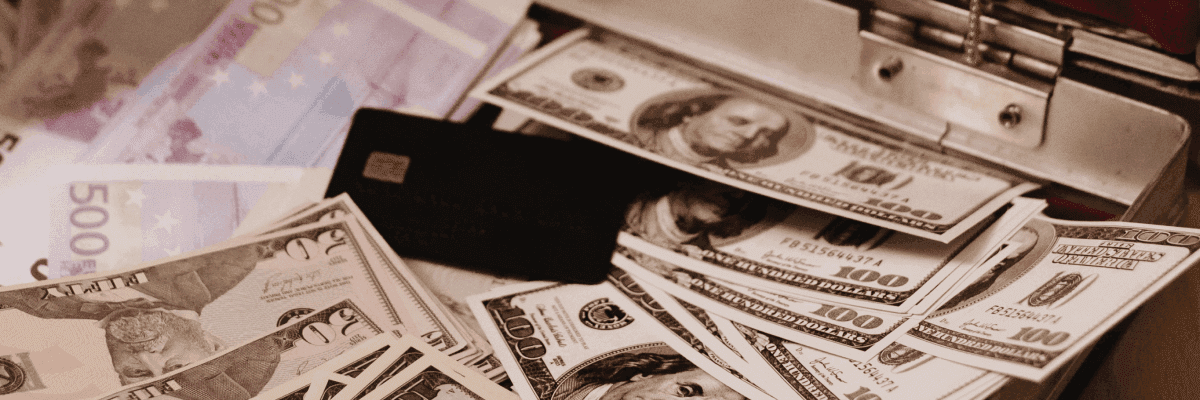In an increasingly digital and cashless world, the convenience of debit cards has become an integral part of our daily lives. Yet, as we embrace this modern payment method, we also expose ourselves to a persistent and evolving threat – debit card fraud.
How does debit card fraud happen, and what can we do to protect ourselves from falling victim to this ever-present danger?
In this article, we will delve into the intricacies of debit card fraud, exploring the various fraudsters tactics and providing valuable insights on safeguarding your hard-earned money.
What is debit card fraud?
Debit card fraud occurs when someone obtains access to your debit card number and, in certain situations, your personal identification number (PIN) to make unauthorized transactions or withdraw funds from your account.
Uncovering the debit card fraud process
The most basic situation that can lead to bank card fraud is when your card is lost or stolen. In this case, dishonest people may engage in fraudulent activity.
Fraudsters may obtain your debit card number, and sometimes your PIN, through various means, including dishonest employees or hackers breaching retailer systems.
Thieves employed a tactic of generating multiple debit card numbers and conducting test transactions until they succeeded. Once they found a valid match, they proceeded to make larger purchases until their activities were detected.
Because of that fraudulent charges can gradually accumulate to over $35,000 before the credit union detects the attack.
However, the rules for using debit cards and those for using credit cards are different. Therefore, there is a difference between credit and debit card fraud.
Credit card companies’ responses to disputes over a potentially fraudulent transaction are governed by the Fair Credit Billing Act (FCBA). This affords you privileges and may aid in recouping your losses.
On the other hand, your debit card issuer must follow the EFTA, which provides less protection in the event of fraudulent charges. As a result, you may end yourself taking on greater liability for fraudulent debit card purchases than for credit card purchases.
Types of debit card fraud
There are many different ways that criminals can commit debit card fraud.
Card-based theft. One of the simplest methods to access someone else’s bank account is to steal their actual debit card. Scammers might go after sensitive information like your bank account number and personal identity documents.
Making contactless payments. By gluing the card reader slot shut, fraudsters coerce victims into utilizing the tap feature on their debit cards. Customers typically don’t realize that their session will remain active for more purchases unless they explicitly end it.
POS skimming. Thieves can steal your credit card information by attaching a “skimmer” to a point-of-sale scanner at a store or petrol station.
When you use your card to make a purchase, the skimmer also reads your card and retains the data. Con artists can then use the copied information as their own.
Hacking attempts. Debit card information is vulnerable to theft while it is in transit. Scanning unsecured transactions done over public Wi-Fi and putting keylogger malware on people’s mobile devices are only two examples of eavesdropping assaults.
Card information is exposed through data breaches. If you buy something with a debit card from a store that later has a data breach, hackers may be able to get your debit card information.
Intercepting mail. Mail fraud occurs when criminals get access to personal information about you through intercepted mail. They may locate the banks where you have accounts and use that information to target your debit card account.
Detecting debit card fraud
Debit card fraud can lead to immediate money loss and disrupt your financial stability, causing scheduled payments to bounce. Detecting fraud early is crucial for mitigating its impact.
Online banking is a highly effective way to monitor your account regularly. By checking your balance and recent transactions daily, you can quickly identify unfamiliar charges and take immediate action by contacting your bank.
In case you notice any suspicious or unexplained activity on your bank account, it’s essential to promptly investigate for fraudulent activities.
How to avoid debit card fraud?
While you can’t do anything when your card is lost or stolen and the damage is already done, you can always take precautions to avoid debit card fraud. Here are some methods that you can use to prevent debit card fraud.
Look out for unauthorized transactions
Regularly monitoring your transactions and account balance empowers you to swiftly identify any suspicious or unauthorized activities, thereby reducing both the likelihood and impact of fraudulent incidents.
Additionally, enrolling in banking alerts offered by most financial institutions is a valuable strategy.
These alerts can notify you via email, text messages, or mobile notifications about specific account events, such as large withdrawals, address changes, or significant purchases.
For enhanced security, it’s recommended to opt for mobile notifications within your banking app, as they are less susceptible to phishing scams.
Go paperless
Opting for paperless bank statements is a smart move, as it eliminates the risk of sensitive account information being stolen from your mailbox.
Digital statements provide a secure online platform for accessing your financial details, minimizing the vulnerability associated with physical mail.
Additionally, when dealing with hard copies of statements or receipts, it’s crucial to store them safely and employ a paper shredder to dispose of unnecessary documents.
This simple yet effective measure significantly reduces the chances of your bank account information falling into the wrong hands through your discarded papers.
Secure your debit card
One fundamental rule to abide by is never to share your debit card PIN, as it constitutes highly sensitive personal information. Moreover, resist the urge to write it down.
Taking a step further, consider embracing the convenience of mobile wallets and payment services, such as Apple Pay or PayPal.
These platforms employ advanced encryption techniques to safeguard your card data during transactions, providing an extra layer of security when making payments through your mobile device.
Furthermore, contactless payments offer an additional layer of protection by allowing you to leave your physical card securely at home.
Instead, you can make payments using your smartphone, which communicates with the payment terminal without the need to swipe or insert your card.
Use credit card
Credit card fraud is relatively less common, thanks in part to the chargeback process that credit card issuers have in place for unauthorized charges. Credit card regulations are notably more stringent, resulting in lower liability limits than debit ones.
Look out for phishing scams
When checking your email or conducting business online, interact with individuals or organizations you can trust.
Be vigilant against identity thieves who may create phishing websites designed to resemble your bank or other businesses where you hold accounts. These scammers seek access to your personal information and might even attempt to breach your bank account.
Additionally, refrain from responding to suspicious emails, texts, or phone calls. Always avoid sharing your debit card details online or with unfamiliar individuals.

Use bank ATMs
Opting for bank ATMs significantly reduces the risk of falling victim to ATM skimming, where fraudsters attempt to steal your debit card information.
They usually take enhanced security measures, including video cameras, setting them apart from ATMs at convenience stores, restaurants, casinos, or public locations.
These bank ATMs are fortified with robust surveillance and security systems. Therefore, it becomes exceedingly difficult for scammers to install card-skimming devices without detection.
Prioritize the bank ATMs within the bank premises accessible solely during regular business hours to maximize security.
Don’t keep all your money in one bank account
It’s advisable not to keep large sums of money within a single checking account, frequently used for everyday purchases.
Instead, consider allocating the majority of your savings to secure interest-bearing accounts like money market accounts or term deposits.
These accounts typically offer higher security levels and impose restrictions that make them impractical for daily use, thus reducing their exposure to potential risks.
You can conveniently transfer your spending money to your debit card every month without incurring penalties, ensuring the security of your funds and the ability to access cash when needed.
📚Related: What Details Do You Need to Transfer Money
Protect your card online
Invest in robust security software such as firewall, anti-virus, and anti-spyware programs for your computer and mobile devices. Also, ensure they are consistently updated to combat evolving threats.
Furthermore, consider employing a Virtual Private Network (VPN) to encrypt your online connection, safeguarding your IP address, location, and identity from prying eyes.
However, be cautious when conducting financial transactions online. It is especially crucial when using public Wi-Fi networks or computers in unsecured locations.
Transmitting sensitive card data over unsecured connections can make you vulnerable to potential hackers.
How to report debit card fraud?
Most debit card agreements have a zero liability policy, which protects cardholders from fraud-related losses. However, you need to prove that the loss resulted from fraud within a specific time frame.
Therefore, when you detect debit card fraud or notice an unfamiliar charge, notify your bank immediately your bank by phone.
Follow up with a detailed letter to document your proactive steps in combating fraud and recovering lost funds. Once you report the loss, you’re no longer liable for fraudulent charges.
Usually, banks investigate unauthorized transactions within ten business days after you notify them. After the deadline, the bank has three days to report its findings.
FAQ
What happens if my debit card is used fraudulently?
You could lose all your money if your bank is not set up to stop suspicious transactions immediately. However, if it happens, your bank or other financial organization can help you get your money back.
📚Read more: Do Banks Refund Scammed Money
How do people do debit card fraud?
Criminals use several methods to steal your card information. The main one is by using an ATM card skimming device.
Also, they can access your old bank statement or a debit card. Moreover, they can steer you to a fake website where they can steal your financial information as you pay.
How serious is debit card fraud?
Like a credit card, a debit card offers little in the way of security against fraudulent use. If a debit card fraud occurs, you may lose all your money.
Moreover, you may be liable for any fraudulent charges up to $50 or a full amount. It depends on how quickly you report debit card fraud.
Do they investigate debit card fraud?
The bank investigates allegations of fraud and other instances of potentially fraudulent behavior. The bank then files a Suspicious Activity Report (SAR) with the relevant government agency.
Is debit card fraud common?
Unfortunately, fraud using debit cards is commonplace. Researchers keeping tabs on this issue found that card fraud, especially debit card fraud, skyrocketed during the pandemic.
In the first two quarters of 2023, the FTC’s Sentinel Network received more than 38,000 allegations of fraud using debit cards. Customers lost over $106 million as a direct result of this.
Read more

